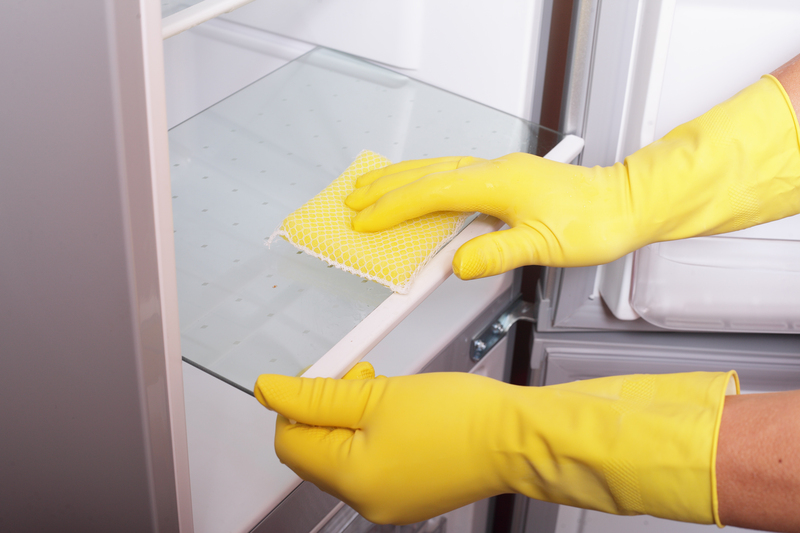The Ultimate Guide to Maintaining Pristine Curtains
Posted on 01/07/2025
The Ultimate Guide to Maintaining Pristine Curtains
Curtains add elegance, warmth, and character to our homes, but over time, they can gather dust, absorb odors, and lose their fresh appeal. Keeping your curtains pristine not only enhances the look of your space but also supports a healthy indoor environment. Whether you have delicate sheers, luxurious velvet drapes, or practical blackout curtains, proper curtain care will keep them looking their best for years. This comprehensive guide covers everything you need to know about maintaining sparkling clean curtains, including cleaning techniques, stain removal, storage tips, and more.

Why Maintaining Clean Curtains Matters
Your curtains play multiple roles--blocking sunlight, protecting privacy, and acting as dust magnets. Here's why regular curtain maintenance is essential:
- Health: Accumulated dust and allergens can aggravate respiratory conditions and allergies.
- Longevity: Dirt and grime can weaken fabrics, leading to fading and tearing.
- Visual Appeal: Pristine curtains elevate your decor and set the mood in any room.
- Odor Control: Curtains can absorb odors from cooking, pets, and smoke without regular cleaning.
Common Curtain Types and Their Cleaning Challenges
Every curtain type demands slightly different care. Understanding fabric composition is the first step toward curtain cleanliness:
- Cotton and Linen: Natural fibers which may shrink if washed in hot water.
- Silk: Very delicate, requiring gentle handling or professional cleaning.
- Polyester and Synthetics: Durable and usually machine-washable.
- Velvet: Needs careful maintenance, often suitable for dry cleaning only.
- Sheer and Lace: Lightweight fabrics that can snag or stretch.
- Blackout Curtains: Often have special linings that might not be compatible with machine washing.
How Often Should You Clean Curtains?
There's no universal schedule, as frequency depends on your living environment and habits. As a rule of thumb:
- Weekly: Shake out dust or use a vacuum to remove surface particles.
- Every 3-6 Months: Deep cleaning is recommended for households with allergies, pets, or smokers.
- Annually: All curtains should be thoroughly cleaned, regardless of exposure.
Step-by-Step Curtain Cleaning Methods
Let's breakdown the most effective ways to keep your curtains sparkling clean based on fabric types and common issues.
Machine Washing Curtains
- Check Care Labels: Always consult the manufacturer's label for fabric-specific instructions.
- Remove Hooks and Weight Bars: Prevents damage to both the machine and curtains.
- Choose Gentle Cycle: Use cold water and a mild detergent for most fabrics.
- Dry Immediately: Hang curtains back on the rod while damp to minimize wrinkles and shrinkage.
Pro tip: For extra-large or heavy curtains, visit a laundromat with commercial-sized machines.
Hand Washing Delicate Curtains
- Fill Tub with Lukewarm Water: Add a small amount of mild liquid detergent.
- Gently Agitate: Avoid excessive wringing or twisting.
- Rinse Thoroughly: Ensure soap residue is fully removed.
- Hang Carefully: Let water drip off and avoid direct sunlight to prevent fading.
Dry Cleaning for Sensitive Fabrics
- Professional Cleaning: Suited for silk, velvet, or heavily lined curtains.
- Spot Clean: For minor stains, use a mild fabric cleaner at home but always test in an inconspicuous area first.
- Discuss Stains: Tell the dry cleaner about tough spots or pet odors for targeted treatment.
Steam Cleaning for Easy Maintenance
- Use a Handheld Steamer: Ideal for refreshing curtains in place with minimal effort.
- Work from Top to Bottom: Smooth out creases while removing dust and light grime.
- Test First: Always verify fabric reaction with a quick steam in a hidden spot.
Spot Cleaning and Stain Removal
Despite your best efforts, accidents happen. Here's how to tackle the most common marks and stains, keeping your curtains immaculate:
General Spot Cleaning Method
- Blot, Don't Rub: As soon as a spill occurs, blot the area with a clean, absorbent cloth.
- Mild Soap Solution: Mix a drop of liquid dish soap with cool water for an effective spot remover.
- Sponge Gently: Avoid soaking fabric to prevent watermarks and fading.
Special Stain Treatments
- Grease: Sprinkle with cornstarch or talcum powder, let sit for 15 minutes, then brush away and spot clean.
- Wine or Juice: Use a mixture of equal parts hydrogen peroxide and water. Test on an inconspicuous spot first.
- Ink: Dab (don't rub) with rubbing alcohol, blotting patiently until the stain lifts.
- Mold and Mildew: Address immediately with a solution of 1 part white vinegar to 4 parts water. Air-dry in sunlight if safe for fabric color.
Note: Always conduct a patch test to avoid damage or discoloration to your curtains.
Daily Curtain Care & Preventive Maintenance
Incorporating simple routines can keep your curtains looking fresh every day, prolonging those deep-clean cycles.
- Vacuum Regularly: Use the upholstery attachment on your vacuum to remove dust, pollen, and pet hair.
- Rotate Curtains: If possible, switch curtain panels occasionally to prevent uneven fading from sunlight.
- Let Sunlight In: Open curtains during the day to help prevent mold growth, but avoid long exposures in direct sunlight for colored or delicate fabrics.
- Shake Curtains Out: Every few days, gently shake them to loosen dust and maintain pleats or folds.
Managing Odors and Freshness
- Fabric Sprays: Use fabric freshener sprays sparingly, choosing those free of harsh chemicals.
- Baking Soda: Lightly sprinkle on the bottom hem, leave for 2 hours, and gently vacuum for a natural deodorizer.
- Essential Oils: Place a few drops on a cotton ball and tuck it discreetly into pleats for a mild fragrance.
Proper Curtain Storage Solutions
If you're redecorating or rotating between seasonal curtains, correct storage is key to preventing odor, yellowing, or mildew.
- Clean Before Storing: Never store dirty curtains. Wash and dry thoroughly first.
- Opt for Breathable Storage: Linen or cotton storage bags allow airflow and deter mustiness.
- Avoid Plastic Bags: They trap moisture and can cause mold or mildew.
- Roll, Don't Fold: Rolling can prevent deep creases and wrinkles.
- Add a Dehumidifier Sachet: Place silica gel or charcoal sachets in bags to draw moisture away.
Ironing and Steaming for the Perfect Finish
Wrinkles can spoil even the cleanest curtains. Here's how to achieve that crisp, tailored look:
- Check Fabric Type: Use an appropriate heat setting, especially for synthetic and blended fabrics.
- Iron While Damp: For cotton and linen, iron while still slightly damp for best results.
- Use Press Cloth: Place a clean towel between the iron and delicate fabrics like silk or lace.
- Steaming on the Rod: Hang curtains and use a handheld steamer from top to bottom, pulling fabric taut as you go.
Tip: Always iron or steam on the reverse side of printed or heavily colored curtains to avoid shine or fade marks.
Professional Curtain Cleaning: When and Why
While most curtains can be cleaned at home, certain scenarios require professional attention:
- Heavy Soiling: Stubborn stains, pet accidents, or persistent odors may need specialized treatment.
- Antique or Designer Curtains: Preserving intricate embroidery or delicate textiles is best left to experts.
- Delicate Linings: Multi-layered or blackout curtains with glued linings should not be submerged in water.
- Complicated Installations: Swags, pelmets, or curtains with elaborate hardware can be carefully removed and cleaned by professionals to avoid damage.
Always request a detailed assessment from your cleaner, and specify if you need hypoallergenic or eco-friendly detergent options.

Frequently Asked Questions on Curtain Maintenance
Can I put all curtains in the washing machine?
Many machine-washable curtains exist, especially synthetics, but always double-check labels. Delicate, lined, or intricate curtains may require alternative care.
How do I prevent curtain shrinkage?
Use cold water, gentle cycles, avoid tumble drying, and hang curtains back on the rod to air-dry and stretch fabric to original dimensions.
Are steam cleaners safe for every curtain type?
Generally, yes for most modern fabrics, but always spot test and avoid using steam on antique or extremely delicate materials.
How do I eliminate persistent odors?
Wash or air out curtains thoroughly. Use natural deodorizers like baking soda and ensure dry, ventilated storage when not in use.
What's the best vacuum attachment for curtain care?
A soft brush attachment is ideal. For delicate sheers or lace, hold the fabric taut while using the vacuum at low suction.
Final Thoughts: Keeping Curtains Pristine All Year Round
The secret to curtain freshness and longevity involves routine care, prompt spot-cleaning, and deep cleaning at reasonable intervals. Always heed fabric recommendations, address stains right away, and refresh curtains with regular airing and gentle vacuuming. With these proven strategies, your curtains will remain immaculate, bringing vibrant color, softness, and style to your home for years to come.
Remember, curtain maintenance is both an aesthetic and health investment. A few simple routines--paired with the right techniques--ensure your living space stays clean, cozy, and effortlessly chic day after day.
Ready for Cleaner, Crisper Curtains?
- Follow these curtain care recommendations.
- Schedule regular cleaning intervals.
- Don't forget to treat yourself--enjoy your revitalized, spotless curtains!
Your home deserves nothing less than pristine curtains and elevated beauty!




